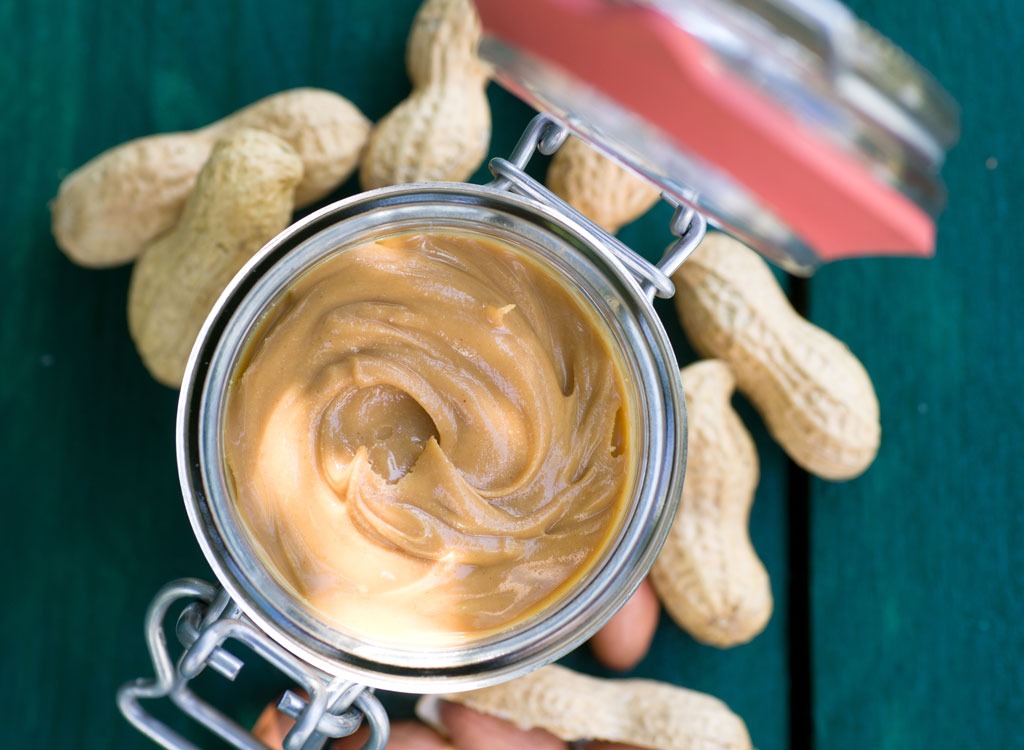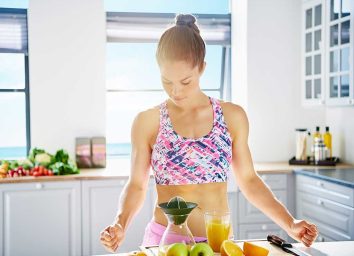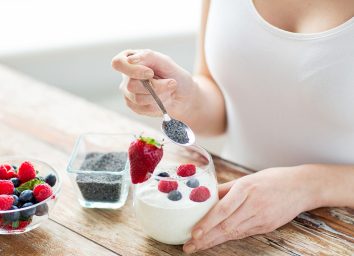11 More Nutrition Myths—Busted

We're here to clear the air. The crack team of researchers at Eat This, Not That! have been hard at work digging into the science behind each issue so we could set the records straight. Learn the truth behind the myths and you'll find you can actually lose weight without all the confusion.
Eating Junk Food Helps Battle Stress
You've been there: Stressed out and sprawled across your sofa with one arm elbow deep in a bag of cheese puffs. In the moment, it can be comforting, but a study published in the British Journal of Psychiatry found that people who consumed the most highly processed foods were 58 percent more likely to be depressed than those who ate the least. Your move: Find a healthy stress snack. Peanut butter and Triscuits do the trick, or check out the next myth.
Dark Chocolate is Good for You
It would be great if the only thing you had to do to eat healthy was look for chocolate bars that were darker than Kristen Stewart's mascara. Unfortunately, the secret to unlocking the health benefits of chocolate are a bit more complicated than that. Plenty of studies have shown that polyphenols—nutrients found in darkly colored plant foods like chocolate—can do everything from lowering blood pressure to raising our ability to burn fat. A 2013 study in the journal Diabetic Medicine even found that eating dark chocolate lessened the effects of high blood sugar in diabetic patients. Unfortunately, the more chocolate is processed, the more of the polyphenols are lost. Creating "Dutch" chocolate, in which an alkalizing agent is added to the cocoa to reduce acidity, destroys up to 77 percent of the nutrients in the cocoa. To get the health benefits that have been touted since the time of Montezeuma, look for a dark chocolate that says 70% cacao (or higher) on the label. The rest? It's just candy.
Oatmeal is Good for You
Okay, oatmeal really is good for you. If it's just oatmeal that you made from scratch, and then sweetened yourself with a little fruit. But most of what's sold as oatmeal today is more like a package of Kool-Ade mix. Consider Instant Quaker Oatmeal Strawberries & Cream, which features delicious sounding "flavored and colored fruit pieces." What does that mean, exactly? What they've done is taken dried apples and/or figs and injected them with corn syrup solids, cornstarch, and trans fats, and mixed it in something called a "creaming agent." Or check out the Fruit & Maple Oatmeal offering at McDonald's. It's a breakfast cereal with 32 grams of sugar–the equivalent of nearly 13 cups of Kix cereal!
Bananas Are the Best Source of Potassium
Your body uses potassium to keep your nerves and muscles firing efficiently, and an adequate intake can blunt sodium's effect on blood pressure. One 2009 study found that a 2:1 ratio of potassium to sodium could halve your risk of heart disease, and since the average American consumes about 3,400 milligrams of sodium each day, your goal should be 6,800 milligrams of daily potassium. You're extremely unlikely to ever reach that mark—and never with bananas alone. One medium banana has 422 milligrams and 105 calories. Here are the sources that earn you roughly the same amount of potassium in fewer calories:
- Potato, half a medium spud, 80 calories
- Apricots, 5 whole fruit, 80 calories
- Cantaloupe, 1 cup cubes, 55 calories
- Broccoli, 1 full stalk, 50 calories
- Sun-dried tomatoes, a quarter cup, 35 calories
Oranges Are the Best Source of Vitamin C
Far more than a simple immune booster, vitamin C is an antioxidant that plays a host of important roles in your body. It strengthens skin by helping to build collagen, improves mood by increasing the flow of norepinephrine, and bolsters metabolic efficiency by helping transport fat cells into the body's energy-burning mitochondria. But since your body can neither store nor create the wonder vitamin, you need to provide a constant supply. An orange is the most famous vitamin-C food, and although it's a good source, it's by no means the best. For 70 calories, one orange gives you about 70 micrograms of vitamin C. Here are five sources with just as much vitamin C and even fewer calories:
- Papaya, ¾ cup, 50 calories
- Brussel's sprouts, 1 cup, 40 calories
- Strawberries, 7 large fruit, 40 calories
- Broccoli, ½ stalk, 25 calories
- Red Bell Pepper, ½ medium pepper, 20 calories
Comfort Food Chases Away the Blues
A bowl of tomato soup and a grilled cheese sandwich on a cold winter's day. A big spoonful of mac & cheese when you're down on your luck. Comfort food just makes you feel better, doesn't it?
Actually, it doesn't. In a 2014 study in the journal Health Psychology, aptly titled "The Myth of Comfort Food," researchers showed participants depressing films to "induce a negative effect." Then they gave them either comfort food, foods that weren't considered comfort foods, or no food at all. Result: The subjects got over their bad moods in equal time, regardless of whether or not they ate. Is feeling bad a good excuse for eating bad? Turns out, it's not. Cheer up—and start slimming down.
Peanut Butter is a Health Food
In its best form, peanut butter actually is a health food. That's because peanuts are packed with monounsaturated fats, the heart-healthy fat that actually helps you lose weight. Here's what the ingredients of a healthy jar of peanut butter should read:
Peanuts.
But most peanut butter doesn't look like that. Here's what the label of Jif Reduced Fat Creamy Peanut Butter Spread reads like:
Peanuts, corn syrup solids, sugar, pea protein, salt, fully hydrogenated vegetable oils, mono and diglycerides, molasses, magnesium oxide, niacinamide, ferric orthophosphate, zinc oxide, copper sulfate, folic acid, pyridoxine hydrochloride.
Now, I know your kids constantly beg you for seconds of pyridoxine hydrochloride, but is that something they need? Most peanut butters are highly processed and loaded with sugars and trans-fatty oils, and contain less of the healthy monounsaturated fats that you truly need. "Peanut butter spread" is even worse. The word "spread" indicates that it's at least 10 percent additives. Look for "natural" peanut butter (Smucker's and Justin's both make great versions) and don't be fooled by any low-fat promises.
"Multi-grain" and "wheat" Breads Are Better Than White Bread
Wait a minute—isn't "multi-grain" one of the biggest buzzwords in nutrition? And haven't we been trained to pick the wheat bread over the white at every turn? Yes, but unfortunately those labels are about as credible as your local congressman's campaign promises. "Wheat bread" is generally white bread with caramel or molasses added to make it look dark and healthy. "Multi-grain" just means that different kinds of junky refined grains may have been used. Always look for the words "100% whole wheat" or "100% whole grain" on the package.
Wraps Are Healthier Than Regular Sandwiches
Those skinny little wraps are so flimsy, so delicate, so fusion-cuisine friendly. How can they not be better than the average lump of bread? Well, consider Subway's wrap, for one. It packs 310 calories—before you even add the first whiff of meat or sauce. The reason is that, in order for the tortilla to wrap around like that, it needs added fat, often in the form of soybean oil and hydrogenated oils. (In fact, when ordering Mexican food, you're usually better off with a hard taco than a soft, for the same reason.)
Potatoes Are Empty Carbs
Once the proud spud stud of the American dinner plate, potatoes have been downgraded in recent years to a status not seen since the Irish blight. But unlike the commentators on cable news, the common taters in your kitchen actually have something worth chewing on. A USDA study of potatoes recently found levels of phytochemicals such as flavonoids and kukoamines that rival the amounts found in broccoli, spinach and Brussels sprouts. Kukoamines? You haven't heard of them because they were previously believed to exist only in Chinese medicinal plants, but they have been shown to lower blood pressure by decreasing free-radical damage and inflammation. If you crave French fries, check out Elevation Burger: Their fries are just potatoes, oil and salt, and they're fried in olive oil.
Nutrition Bars Are Actually Nutritious
In a world where we really called it as it is, nutrition bars would be known by another name: calorie bars. Most of them are so polluted with additives that their ingredients list looks like Charlie Sheen's blood test results. For example, PowerBar Vanilla Crisp touts itself as "fuel for optimum performance," but unless you're talking about a performance by The Chemical Brothers, we're not sure exactly what they mean. With four different types of sugar, it packs more of the white stuff than an adult woman should eat in an entire day. If you like the idea of a snackable bar that packs in the nutrition, read the ingredients carefully: Brands like KIND, Larabar, and Clif have plenty of smart offerings. But most of what's out there is just candy.








